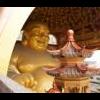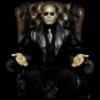Search the Community
Showing results for tags 'Footbinding'.
-
An interesting read on the T'ang Dynaty as reviewed in the NY Times... China's Golden Age By Eliot Weinberger 1. Women in the courts of the T'ang Dynasty, between 618 and 907, painted their eyebrows green; the standard of beauty was to have brows as delicately curved as the antennae of moths. Foreheads were powdered yellow with massicot, a lead oxide, for yellow was the color of vitality. Plumpness, as in many societies where the masses are hungry, was the ideal and useful, men claimed, in winter: in the poorly heated palaces, a prince or minister could huddle his heftiest concubines around him to protect him from drafts. There are at least twenty-four hairstyles mentioned in T'ang poetry, some a foot high, held together by lapis lazuli hairpins clattering with pearls, with silk flowers and birds of gold perched on the top. As the empire was crumbling, the most popular styles had names such as "Deserting the Family" and "Uprooting the Grove." Yang Kuei-fei, the emperor Hs¨¹an Tsung's beautiful courtesan whose machinations set off a civil war, kept a tiny jade fish in her mouth. The empire, expanding and contracting with conquests and defeats, at its height stretched east to the China Sea, south to Annam, and west along the Silk Road as far as Samarkand. The Grand Canal, a massive feat of construction 1,200 miles long, linked north and south, and a network of highways and waterways connected 1,859 cities, twenty-two of them with populations of at least half a million. The capital, Ch'ang-an (present-day Xi'an in central China), was the largest city in the world, some thirty square miles, laid out in a grid pattern with wide avenues lined with fruit trees and patrolled by unforgiving policemen, the Gold Bird Guards. Nearly two million inhabitants were apportioned into 108 walled wards, including two vast markets with hundreds of lanes, strictly organized according to goods and services; parks with artificial lakes and mountains and imported birds and game; and an extensive Pleasure Quarters of banquet halls and brothels. Every aspect of life was codified and enforced by imperial edict: the length of tunics, the price of each item in the market, the colors that may be worn by ministers of certain ranks, the number of blows with a thin rod that a speeding coachman should receive. There were prohibitions against eating a white sheep that had a black head or a dish of pheasants with walnuts. Censuses of every village were taken to ensure an exact collection of taxes and to fill the ranks of compulsory labor and conscription. The country was converted to a cash economy and the foundation of imperial wealth became its tax on salt, a commodity everyone needed. Under the T'ang, the system of strict examinations on the classics as a requirement for entering the civil service became universal; one census listed 130,000 students. Although this hardly resulted in a meritocracy, it meant that some young men who did not come from well-connected families could rise to powerful positions in the government, and an increasing number of talented¡ªor, at least, educated¡ªpeople entered the bureaucracy. The T'ang became rich on trade, promoted by a new merchant class along the Silk Road (where Sogdian was the lingua franca) or on the sea routes that led to the port of Canton (where the sailors spoke Persian). Coral from the Mediterranean or Ceylon; golden peaches from Samarkand; cardamom from Tonkin; "thousand-year" jujubes from Tabaristan; ostrich-egg cups from Bukhara; various peppers from Burma; feathers from the white egrets, peacocks, and kingfishers of Annam (one princess had a dress made entirely from feathers); pistachios from Persia; furs of sable, ermine, miniver, steppe foxes, and martens.... The list of T'ang imports is endless, and T'ang coins have been found as far west as the coast of Somalia. The masses, who rarely saw these treasures, told tales of strange objects with magical powers, brought from abroad: a single bean that was sufficient food for weeks; a certain wheat that made the body so light that one could fly; a crystal pillow that gave the sleeper visions of strange lands; a piece of rhinoceros horn that could heat a palace; hairpins that turned into dragons; pots that cooked without fire; the translucent stone that emitted a cool breeze; the plant that was always surrounded by darkness. All things foreign were the rage. Aristocrats learned to sit in chairs, the "barbarian beds." Dandies preferred to speak Turkish, and set up blue felt nomadic tents in their urban courtyards, where they dressed like khans and ate chunks of lamb that they cut off with swords. Courtesans sang songs with titles like "Watching the Moon in Brahman Land," playing melodies on foreign instruments adapted from Indian, Turkish, Korean, and Persian tunes. Entertainment was provided by dancers from Tashkent or the Sogdian "twirling girls" who performed balancing on giant balls. Saffron-flavored wine, made from grapes imported from Turkey, was served in agate cups, poured in the Pleasure Quarters by blue-eyed geishas. "When I drink this," said the emperor Mu Tsung, "I am instantly conscious of harmony suffusing my four limbs¡ªit is the true Princeling of Grand Tranquility"¡ªthe latter being an honorific for Lao Tzu, the Taoist sage. It was a time of inordinate leisure. Mandarins were given fifty-eight days off during the year to celebrate twenty-eight holidays. There were holidays for viewing the moon and for attempts to outshine it. (One emperor erected a lantern tree two hundred feet tall with 50,000 oil cups lit by a thousand palace women costumed in brocade.) Periodically the emperor would declare a three-day carnival in the streets, with floats five stories high carrying acrobats swinging on poles, musicians, and singers. In the palace, the bureaucratic office known as the Service of Radiant Emolument was in charge of imperial banquets; the cooking alone was handled by a staff of two thousand, preparing such rare dishes as steamed bear claw, Bactrian camel hump, jellyfish with cinnamon, proboscis monkey soup with five flavors, barbequed elephant trunk, and, in summer, melons that were kept cool in jade urns of ice brought down from the mountains. The aristocracy wanted it all to last forever; they drank strange elixirs concocted by Indian charlatans and Taoist alchemists that would promote longevity or even ensure immortality. It is said that five of the T'ang emperors died from these potions. In Ch'ang-an there were churches and temples, synagogues and mosques for Nestorian Christians, Manichaeans, Zoroastrians, Muslims, and Jews. But by far the most popular of the imported religions was Buddhism, which had been brought from India some centuries before and was actively promoted in the T'ang by the notoriously ruthless Empress Wu, the only woman emperor in Chinese history and perhaps second only to Elizabeth I as the most powerful woman who ever lived. (Her Buddhism was more calculating than spiritual, for Confucianism would never have permitted a woman on the throne.) Chinese pilgrims spent years on the long journey to India to visit the sacred places and gather scrolls, and hundreds of scholar monks were installed in the imperial palace to translate and interpret the texts¡ªone catalog lists translations of 2,487 different works. Poets and intellectuals preferred the asceticism and the enlightenment through nature in the Ch'an school, which became Zen in Japan. The masses venerated the Buddha Amitabha and the compassionate bodhisattva Kwan-yin, hoping to be reborn in the paradise of the Pure Land on the way to nirvana. The vast wealth accumulated by the temples and monasteries, channeled into enterprises like mills and oil presses, moneylending and the opening of agricultural lands, further expanded the economic boom. It is a measure of Buddhism's reach that when, toward the end of the dynasty, the emperor Wu Tsung turned against the religion as an economic rival to the state, 4,600 monasteries and 40,000 shrines were destroyed, and a quarter of a million monks and nuns were defrocked. Buddhism in China never recovered. The T'ang invented printing, for Buddhists believed that one gathered karmic merit by the ceaseless repetition or reproduction of the sacred texts. (A single monastery in Ch'ang-an had a thousand copies of the Lotus Sutra.) The imperial library had some 200,000 books and scrolls, classified and labeled under four categories: Classics, Histories, Philosophers, and Collections. Individual scholars had private libraries with tens of thousands of books. The T'ang invented toilet paper, which was viewed with disgust by foreign visitors. They invented gold plating, true porcelain, and the magnetic needle; they excelled, as might be expected, at cartography. During the T'ang, the Chinese acquired their taste for tea, which quickly¡ªand typically¡ªbecame so refined that one connoisseur wrote a treatise on the sixteen ways of boiling water and their particular effects on brewing the leaves. And yet there were also forty-two recorded famines, and wars with the Tibetans, the Uighur Turks, the Khitan of Manchuria, the southern nation of Nan-Chao (now in Yunnan province), the Koreans, and the Annamese. Emperors rose by assassinating their siblings, children, parents, uncles, cousins, and were assassinated themselves in turn. Eunuchs staged attempted coups, killing thousands of officials. In the civil war known as the An Lu-shan Rebellion (755¨C763), tens of millions died. The poet Tu Fu writes of fields overrun with nettles, for there were no men left to work the land; of fifteen-year-olds sent off to war who returned as old men, if they returned at all; of white bones bleached in the sun on the far western borders, where the lamentations of the living mingle with the eerie whimperings of ghosts.



